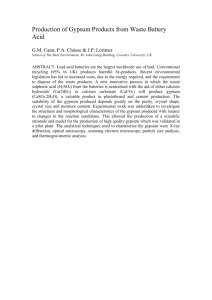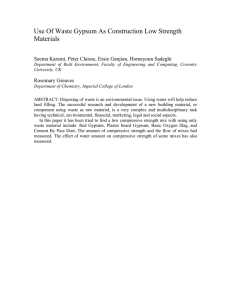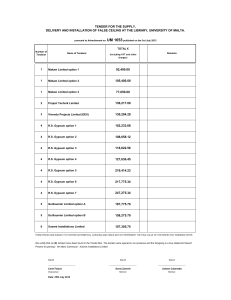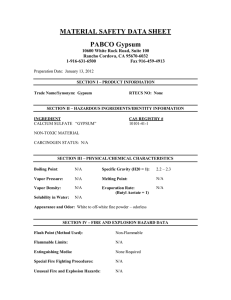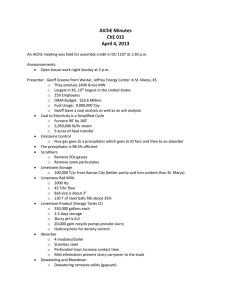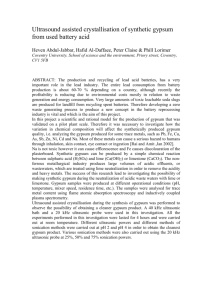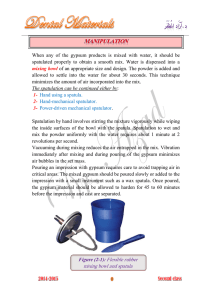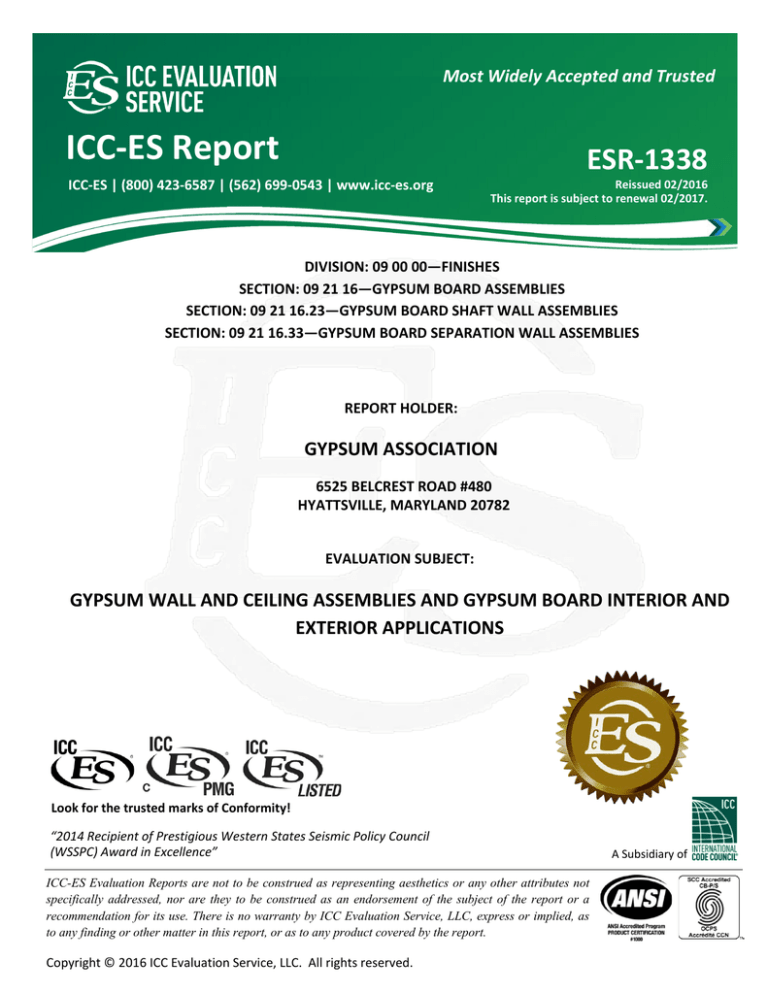
Most Widely Accepted and Trusted
0
ICC-ES Report
ICC-ES | (800) 423-6587 | (562) 699-0543 | www.icc-es.org
000
ESR-1338
Reissued 02/2016
This report is subject to renewal 02/2017.
DIVISION: 09 00 00—FINISHES
SECTION: 09 21 16—GYPSUM BOARD ASSEMBLIES
SECTION: 09 21 16.23—GYPSUM BOARD SHAFT WALL ASSEMBLIES
SECTION: 09 21 16.33—GYPSUM BOARD SEPARATION WALL ASSEMBLIES
REPORT HOLDER:
GYPSUM ASSOCIATION
6525 BELCREST ROAD #480
HYATTSVILLE, MARYLAND 20782
EVALUATION SUBJECT:
GYPSUM WALL AND CEILING ASSEMBLIES AND GYPSUM BOARD INTERIOR AND
EXTERIOR APPLICATIONS
Look for the trusted marks of Conformity!
“2014 Recipient of Prestigious Western States Seismic Policy Council
(WSSPC) Award in Excellence”
ICC-ES Evaluation Reports are not to be construed as representing aesthetics or any other attributes not
specifically addressed, nor are they to be construed as an endorsement of the subject of the report or a
recommendation for its use. There is no warranty by ICC Evaluation Service, LLC, express or implied, as
to any finding or other matter in this report, or as to any product covered by the report.
Copyright © 2016 ICC Evaluation Service, LLC. All rights reserved.
A Subsidiary of
ICC-ES Evaluation Report
ESR-1338
Reissued February 2016
Corrected April 2016
This report is subject to renewal February 2017.
www.icc-es.org | (800) 423-6587 | (562) 699-0543
A Subsidiary of the International Code Council ®
3.0 DESCRIPTION
DIVISION: 09 00 00—FINISHES
Section: 09 21 16—Gypsum Board Assemblies
Section: 09 21 16.23—Gypsum Board Shaft Wall
Assemblies
Section: 09 21 16.33—Gypsum Board Area Separation
Wall Assemblies
The gypsum products and fire-resistance-rated wall, floorceiling and roof-ceiling assemblies must conform to
Section 4.0 of this report using materials as described
below.
3.1 Water-resistant Gypsum Backing Board:
REPORT HOLDER:
The backing board must conform to ASTM C1396.
GYPSUM ASSOCIATION
6525 BELCREST ROAD #480
HYATTSVILLE, MARYLAND 20782
(301) 277-8686
www.gypsum.org
3.2 Gypsum Wallboard:
The wallboard must conform to ASTM C1396.
3.3 Exterior Gypsum Soffit Board:
The soffit board must conform to ASTM C1396.
EVALUATION SUBJECT:
3.4 Gypsum Sheathing Board:
GYPSUM WALL AND CEILING ASSEMBLIES AND
GYPSUM BOARD INTERIOR AND EXTERIOR
APPLICATIONS
The sheathing board must conform to ASTM C1396.
3.5 Gypsum Backing Board, Core Board and Gypsum
Shaftliner Board:
1.0 EVALUATION SCOPE
The backing, core board and shaftliner must conform to
ASTM C1396.
Compliance with the following codes:
2015, 2012 and 2009 International Building Code® (IBC)
2015, 2012 and 2009 International Residential Code
(IRC)
2013 Abu Dhabi International Building Code (ADIBC)
®
†
†
The ADIBC is based on the 2009 IBC. 2009 IBC code sections referenced
in this report are the same sections in the ADIBC.
Properties evaluated:
Interior finish
Fire-resistance
3.6 Gypsum Base for Veneer Plasters:
The gypsum base must conform to ASTM C1396.
3.7 Gypsum Ceiling Board:
The ceiling board must conform to ASTM C1396.
3.8 Screws:
Type S, Type W and Type G screws specified for the
assemblies described in this report must comply with
ASTM C1002 or ASTM C954.
4.0 INSTALLATION
Sound control
4.1 General:
Structural
Installation of the gypsum board wall and ceiling
assemblies and interior and exterior applications as
described below must comply with this report and the
Gypsum Association’s published installation instructions.
The Gypsum Association’s published installation
instructions must be available at the jobsite at all times
during installation.
Thermal barrier
Exterior finish
2.0 USES
This evaluation report recognizes gypsum products for
specific interior and exterior applications, and also
recognizes various load-bearing and nonload-bearing fireresistance-rated wall, floor-ceiling and roof-ceiling gypsum
board assemblies. Some assemblies also provide sound
transmission control. Structural evaluation is limited to
transverse loading.
The gypsum products recognized in this report must be
assembled and installed in accordance with IBC Section
2508.1 or IRC Section R702.3.1, as applicable. Gypsum
board must not be used in areas subject to continuous high
humidity, such as saunas, steam rooms, gang shower
rooms or indoor pools.
ICC-ES Evaluation Reports are not to be construed as representing aesthetics or any other attributes not specifically addressed, nor are they to be construed
as an endorsement of the subject of the report or a recommendation for its use. There is no warranty by ICC Evaluation Service, LLC, express or implied, as
to any finding or other matter in this report, or as to any product covered by the report.
1000
Copyright © 2016 ICC Evaluation Service, LLC. All rights reserved.
Page 1 of 5
ESR-1338 | Most Widely Accepted and Trusted
4.2 Fire-resistance-rated Wall, Floor-ceiling and Roofceiling Gypsum Board Assemblies:
4.2.1 General Fire-resistance-rated Design Information:
a.
b.
The axial design stress of the wood studs used in fireresistive construction must be reduced to 0.78Fʹc,
calculated in accordance with Section 3.6 of the
ANSI/AWC National Design Specification (NDS) for
Wood Construction 2015 edition for the 2015 IBC,
2012 edition for the 2012 IBC and 2005 for the 2009
IBC, with the maximum design stress not greater than
78 percent of the calculated allowable stress with
studs having a slenderness ratio, le/d, of 33.
When gypsum board is used in fire-resistive
floor/ceiling, roof/ceiling, or wall assemblies, the board
thickness, type of gypsum board, and construction of
the assembly must comply with Chapter 7 of the IBC;
Section R302 of the IRC; the Gypsum Association
th
Fire Resistance Design Manual, 20 Edition for the
th
2015 IBC or 19 Edition for the 2012 and 2009 IBC;
or current ICC-ES evaluation reports. The Gypsum
Association Fire Resistance Design Manual 2015 GAst
600 (21 Edition), although not specifically listed as a
reference standard in the 2009, 2012, or 2015 IBC, is
an acceptable alternative to the 19th and 20th Editions
when approved by the code official.
Page 2 of 5
layer is laminated in the same manner as the second layer,
and is further attached using 11/2-inch-long (38 mm), Type
G screws spaced 24 inches (610 mm) on center along the
edges and along the center, and held back 21/2 inches
(63.5 mm) from the top and bottom edges. The fourth layer
is fully laminated, with all of the vertical joints being offset.
4.2.2.2 One-hour Gypsum Board Partition with Wood
Framing: The framing consists of nominal 2-by-4 wood
studs spaced 16 inches (406 mm) on center, with blocking
of the same size at midheight. Each side of the wall is
covered with a single layer of 5/8-inch-thick (15.9 mm),
Type X gypsum board applied either perpendicular to or
parallel to the framing. The gypsum board is attached to
the framing using No. 6 by 11/4-inch-long (31.7 mm),
buglehead, Type W screws spaced 8 inches (203 mm) on
center along end joints and 12 inches (305 mm) on center
1
in the field. Screws are placed no closer than /2 inch
(12.7 mm) to end or edge joints. Vertical joints are
staggered 16 inches (406 mm) on center, and horizontal
joints are staggered 12 inches (305 mm) on center on each
side. The joints are taped with joint tape and covered with
two coats of joint compound. Screw heads are covered
with joint compound.
4.2.2 Fire-resistance-rated Assemblies: Generic fireresistance-rated systems (those not designated as
proprietary in the listing), as listed in the Gypsum
Association Fire Resistance Design Manual, 20th Edition
for the 2015 IBC, or 19th edition for the 2012 and 2009
IBC, are recognized for use. The Gypsum Association Fire
st
Resistance Design Manual 2015 GA-600 (21 Edition),
although not specifically listed as a reference standard in
the 2009, 2012, or 2015 IBC, is an acceptable alternative
to the 19th and 20th Editions, when approved by the code
official.
4.2.2.3 One-hour Gypsum Board Staggered-stud
Bearing Partition: The framing consists of two rows of
nominal 2-by-3 wood studs spaced at 16 inches (406 mm)
on center or nominal 2-by-4 wood studs spaced at
24 inches (610 mm) on center, with blocking of the same
size at midheight. Studs in opposite rows are staggered
8 inches (203 mm) or 12 inches (305 mm) on center, and
the rows are spaced a minimum of 1 inch (25.4 mm) apart.
The plates for each row may be of the same size and
material, or common plates may be used for the two rows.
5
The exterior face of each row is then covered with /8-inchthick (15.9 mm), Type X gypsum board applied horizontally
or vertically using 6d cement-coated cooler nails at
7 inches (178 mm) on center, with end joints on nailing
members. Fire-blocks, when required, may be of mineral
wool batts, 2 inches (51 mm) thick in the intervening
spaces between the two rows of studs, or 1/2-inch-thick
(12.7 mm) gypsum board. Where nominally 2-by-3 studs
are used, they must be stress-graded lumber as set forth in
Tables 4A through 4D of the NDS.
4.2.2.1 Two-hour Gypsum Board Solid Partition for
Shaft Enclosure: The assembly is similar to Item 9-1.1 of
Table 721.1(2) of the 2015 and 2012 IBC, Item 9-1.1 of
Table 720.1(2) of the 2009 IBC, except that the gypsum
shaftliner is first installed onto 2-by-2-inch (51 by 51 mm)
steel floor and ceiling runners using Type S screws spaced
12 inches (305 mm) on center. The runners must be
anchored at 24 inches (610 mm) on center, using
approved fasteners. Two layers of 1/2-inch-thick (12.7 mm),
Type X gypsum board installed with long edges parallel to
wrapped coreboard edges are laminated to one side of the
coreboard. All vertical joints must be offset at least
3 inches (76 mm).
4.2.2.4 One-hour Gypsum Board Floor-ceiling or
Roof-ceiling Assembly with Wood Framing: The ceiling
construction is identical to assembly FC5406 in the
Gypsum Association Fire Resistance Design Manual.
Alternate framing consists of lower chords of trussed
rafters, or pitched or flat trusses spaced a maximum of
24 inches (610 mm) on center. Alternate fasteners, having
the same spacing as the screws, are 17/8-inch-long
(47.6 mm), 6d, cooler, box or wallboard nails for the base
ply, and 23/8-inch-long (60 mm), 8d, cooler, box or
1
wallboard nails for the face ply. Type G screws, 1 /2 inches
(38 mm) long, are still required at the end joints of the
gypsum board face layer.
The assembly may also be constructed with four layers
1
of /2-inch-thick (12.7 mm), Type X gypsum board,
laminated together, with the joints of each layer offset at
least 3 inches (76 mm) from the adjoining layers. The
laminating compound must comply with ASTM C475 or be
an approved powder setting–type compound. The first
layer is attached to the 2-by-2-inch (51 by 51 mm) steel
7
floor and ceiling angle runners using one /8-inch-long
(22 mm), Type S screw at each corner. The second layer
is then fully laminated to the first layer and screw-attached
to the runners using 115/16-inch-long (49.2 mm), Type S
screws spaced 12 inches (305 mm) on center. The third
4.2.2.5 One-hour
Gypsum
Board
Roof-ceiling
Assembly with Steel Framing: The assembly consists of
steel roof framing with roof purlins spaced and designed to
support a noncombustible ceiling grid to which is attached
double 5/8-inch-thick (15.9 mm), Type X gypsum board.
Cold-rolled steel main runner channels at 4 feet (1219 mm)
on center, with size and hanger support complying with
Section 2506.2.1 of the IBC, are hung from the steel
7
framing. Number 25 gage, /8-inch-deep (22 mm), rigid
cross-furring channels are spaced 24 inches (610 mm) on
center. Furring channels are wire-tied to the runner
channels using loops of No. 16 gage wire. The base layer
c.
Except where otherwise noted in this report, any of
the gypsum boards listed in Section 3.0, of the same
size, thickness, and core type specified, may be used.
The gypsum base for veneer plasters must be
covered with minimum 1/16-inch-thick (1.6 mm)
gypsum veneer plaster.
ESR-1338 | Most Widely Accepted and Trusted
of 5/8-inch-thick (15.9 mm), Type X gypsum board is
applied at right angles to the furring channels using 1-inchlong (25.4 mm), Type S screws spaced at 24 inches
(610 mm) on center. The face layer of 5/8-inch-thick
(15.9 mm), Type X gypsum board is applied at right angles
to the furring channels, using 15/8-inch-long (41.3 mm),
Type S screws spaced at 12 inches (305 mm) on center at
joints, driven through the base layer and into the
intermediate furring channels. Face layer joints are offset
24 inches (610 mm) from the base layer joints. One-andone-half-inch-long (38 mm), Type G screws, placed
2 inches (51 mm) from either side of the face layer end
joints, are also installed at 12 inches (305 mm) on center.
The addition of insulation to the assembly is permitted,
provided a minimum plenum space of 10 inches (254 mm)
is maintained between the underside of the insulation and
the gypsum panel.
4.2.2.6 Two-hour Gypsum Board Bearing Wall with
Minimum STC (Sound Transmission Class) 50 Sound
Rating: The construction consists of nominally 2-by-4
wood studs spaced 16 inches (406 mm) on center, faced
5
on each side with two layers of /8-inch-thick (15.9 mm),
Type X gypsum board. On one side, the gypsum board is
fastened directly to the studs as specified for interior
partitions in Item 14-1.5 of Table 720.1(2) of the IBC; on
the other side, resilient furring channels spaced 24 inches
(610 mm) on center are applied horizontally over the wood
studs and are attached using 6d common or 11/4-inch
(31.7 mm) wallboard nails or 1-inch-long (25.4 mm), Type
W or Type S screws. The 5/8-inch-thick (15.9 mm), Type X
gypsum board is applied horizontally and is attached along
longitudinal edges to the furring channels using 1-inch-long
(25.4 mm), Type S screws spaced 12 inches (305 mm) on
center. Six-inch-wide (152 mm) strips of gypsum board are
installed behind unsupported vertical butt joints and are
attached at the ends and along the length of the strips
1
using Type G, 1 /2-inch-long (38 mm) screws spaced
12 inches (305 mm) on center. A face layer of 5/8-inch-thick
(15.9 mm), Type X gypsum board is applied with joints
staggered from the base layer joints and secured to the
5
resilient furring channels using 1 /8-inch-long (41.3 mm),
Type S screws spaced 12 inches (305 mm) on center. With
this partition, a minimum STC rating of 50 is attained.
When desired, glass fiber or mineral wool insulation may
be installed in the stud cavities.
4.2.3 Alternate Fire-resistance-rated Construction:
4.2.3.1 Alternate Suspended Ceiling Construction:
Gypsum board ceilings directly attached to steel framing as
set forth in Table 721.1(3) of the 2015 and 2012 IBC, Table
720.1(3) of the 2009 IBC may be suspended by means of
11/2-inch (38 mm), cold-rolled steel, main runner channels,
spaced 48 inches (1219 mm) on center, that are
suspended with No. 8, SWG galvanized wire hangers
spaced 48 inches (1219 mm) on center. Furring channels
are placed perpendicular to the cold-rolled steel main
runner channels and are secured thereto using No. 18,
SWG galvanized wire ties (double strand); the gypsum
board is then installed in the manner required for direct
attachment.
4.2.3.2 Alternate Gypsum Board Fasteners: Screws,
either Type W or Type S, depending on the framing
member, may be used in lieu of nails in fire-resistancerated assemblies described in this report or described in
Tables 721.1(2) and 721.1(3) of the 2015 and 2012 IBC,
Tables 720.1(2) and 720.1(3) of the 2009 IBC, provided
the screw penetration into the framing member is
equivalent to the nail penetration, the screw spacing is the
same as the nail spacing, and the cross-sectional area of
the screws is equal to that of the specified nails.
Page 3 of 5
4.2.3.3 Joint Treatment: For the fire-resistive assemblies
in this report, taping and finishing of joints and fasteners is
permitted to be omitted in the following cases:
a.
Where there is square-edge gypsum board or tongueand-groove-edge (V-edge) gypsum backing board or
gypsum sheathing.
b.
In single-layer applications on wood-framed
assemblies where joints fall over framing members.
c.
On inner layers and outer layers of multiple-layer
wood-framed or steel-framed assemblies, where the
joints of adjacent layers are offset from each other.
4.3 Sound Control Systems:
Generic sound control systems, as listed in the Gypsum
th
Association Fire Resistance Design Manual, 20 Edition
for the 2015 IBC, or 19th edition for the 2012 and 2009
IBC, are recognized for use. The Gypsum Association Fire
Resistance Design Manual 2015 GA-600 (21st Edition),
although not specifically listed as a reference standard in
the 2009, 2012, or 2015 IBC, is an acceptable alternative
th
th
to the 19 and 20 Editions when approved by the code
official. Partition systems must be sealed at perimeter and
around cut-outs using beads of nonhardening caulking
compound, except that tape and joint compound are
permitted to be used in lieu of caulking above the top plate
in wood-framed systems. Where carpet and pad are
specified for the IIC sound rating shown in the manual, the
carpet must be a 44-ounce (1492 g/m2) wool carpet with a
40-ounce (1356 g/m2) hair pad.
Except where otherwise noted in this report, any of the
gypsum boards listed in Section 3.0, of the same size,
thickness, and core type specified, may be used.
4.4 Allowable Partition Heights:
4.4.1 Gypsum Board or Veneer Base: To comply with
Section 1607.14 and Table 1604.3 of the 2015 and 2012
IBC, Section 1607.13 and Table 1604.3 of the 2009 IBC,
the allowable height limits of non-bearing partitions are as
follows:
Partitions utilizing No. 25 gage [minimum 0.0179 inch
(0.454 mm) uncoated base-metal thickness] steel channel
studs conforming to ASTM C645 must have maximum
heights as set forth in a current ICC-ES evaluation report.
Mechanical fastening of intermediate studs to the track is
not required unless this is specified in the evaluation
report.
4.5 Joint Treatment at Areas to Receive Tile:
Gypsum board joints, including those at all angle
intersections, which are under areas to receive tile or wall
panels, must be treated with joint compound and tape, but
must not be finish-coated. All cut edges and openings
around pipes and fixtures must be treated with an
approved, water-resistant, flexible compound or caulk.
Areas to be tiled that are covered with a joint compound
must be skim-coated with bedding adhesive. The bedding
adhesive for ceramic tile must conform to ANSI A136.1 for
Organic Adhesives for Installation of Ceramic Tile, Type I.
4.6 Exterior Surfaces:
4.6.1 Exterior Ceiling Surfaces:
4.6.1.1 Location: Exterior gypsum soffit board may be
used as a ceiling finish at exterior locations such as
carports, open porches, walkways, soffits and similar
installations that are horizontal or inclined downward away
from the building. Gypsum wallboard is permitted for use
as a ceiling finish at exterior horizontal applications not
ESR-1338 | Most Widely Accepted and Trusted
exposed to the weather as defined by Section 2502 of the
IBC, or Section R702.3.5 of the IRC.
4.6.1.2 Framing: Maximum spacing of framing members
must be 16 inches (406 mm) on center when supporting
1
/2-inch-thick (12.7 mm) board, and must be 24 inches
5
(610 mm) on center when supporting /8-inch-thick
(15.9
mm)
board.
Gypsum
board
applications
perpendicular to framing members must comply with
ASTM C840 (IBC), or Table R702.3.5 of the IRC.
4.6.1.3 Joints: In ceiling areas having long runs, the
maximum spacing of expansion joints must be 30 feet
(9.144 m). A 1/4-inch (6.4 mm) clearance joint is required
between gypsum board and adjacent walls, fascia, beams
or columns. Fascia boards must extend downward past the
1
ceiling board surface a minimum of /4 inch (6.4 mm).
Exterior gypsum soffit board or gypsum wallboard joints
and fastener heads must be provided with joint treatment.
An alternate joint treatment is batten strips.
4.6.1.4 Surface Treatment: The exterior gypsum soffit
board and the gypsum wallboard as allowed by the
applicable code must have one of the following surface
treatments applied at the jobsite:
a.
One coat of latex exterior paint applied over an oilbase primer.
b.
Two coats of an oil- or alkyd-based exterior paint.
4.7 Thermal Barrier:
Regular gypsum board, a minimum of 1/2-inch (12.7 mm)
thick, is permitted to be used as a thermal barrier in
accordance with Sections 2603.4 or 2603.5.2 of the IBC or
Section R316.4 of the IRC. The gypsum board must be
attached in such a manner that it will remain in place for
15 minutes of fire exposure. For walls constructed of wood
framing, attachment of the gypsum board in accordance
with ASTM C840 (IBC), or IRC Section R702.3.5, is
permitted. For other construction, attachment of the
gypsum wallboard must comply with a specific ICC-ES
evaluation report, or the method of attachment must be
qualified by testing in accordance with FM 4880, UL 1040,
NFPA 286 or UL 1715 (IBC and IRC).
4.8 Shear Walls:
Table 1 shows maximum allowable shear values for
gypsum board shearwalls. Gypsum board must be applied
either horizontally or vertically on nominally 2-by-4 (50 by
102 mm) wood studs. Additionally, Section 2505 of the IBC
or R602.10 of the IRC is applicable.
5.0 CONDITIONS OF USE
The gypsum board wall and ceiling assemblies and interior
and exterior applications described in this report comply
with, or are suitable alternatives to what is specified in,
those codes listed in Section 1.0 of this report, subject to
the following conditions:
Page 4 of 5
5.1 Installation must comply with this report, the Gypsum
Association’s published installation instructions and
the applicable code. In the event of a conflict between
the Gypsum Association’s published installation
instructions and this report, this report governs.
5.2 Partition construction and heights are as set forth in
this report. Indicated stud spacings are maximums.
Stud sizes (depths) and gages are minimums.
5.3 Allowable shear for vertical diaphragms (shearwalls)
must be reduced by 50 percent for dynamic loading
due to earthquake in Seismic Design Category D in
areas adopting the IBC or IRC. In jurisdictions
adopting the IBC or IRC, gypsum board must not be
used to resist seismic forces in structures in Seismic
Design Category E or F.
5.4 Documentation must be submitted to the code official
verifying that the gypsum board products to be
installed comply with the applicable standard noted in
Section 3.0 of this report.
5.5 Calculations and details must be submitted to the
code official for approval of structural-use
applications.
6.0 EVIDENCE SUBMITTED
6.1 Reports of testing in accordance with ASTM E119
(UL 263).
6.2 Reports of testing in accordance with ASTM E84
(UL 723).
6.3 Reports of transverse load testing in accordance with
UL 1296.
6.4 Reports of sound transmission testing in accordance
with ASTM E90 and ASTM E413.
6.5 Reports of testing in accordance with ASTM C473.
6.6 Reports of racking shear wall testing in accordance
with ASTM E72.
7.0 IDENTIFICATION
Gypsum boards must be identified by the manufacturer’s
name, the thickness, the brand name and the ASTM
specification. Gypsum board products that have been
evaluated by ICC-ES for compliance with the standards
indicated in Section 3.0 of this report must also be
identified by the ICC-ES report number associated with the
specific product.
Bundles of steel studs must be identified as set forth in a
current ICC-ES evaluation report on the product. Screws
must be identified on the packaging by the name, brand or
trademark of the producer or supplier and the ASTM
designation.
ESR-1338 | Most Widely Accepted and Trusted
Page 5 of 5
TABLE 1—ALLOWABLE SHEAR FOR WIND OR SEISMIC FORCES (pounds per foot)
1, 2
FOR VERTICAL DIAPHRAGMS OF GYPSUM BOARD WOOD-FRAMED WALLS
BOARD
THICKNESS
(in.)
WALL
CONSTRUCTION
MINIMUM FASTENER SIZE
3
MAXIMUM STUD
SPACING (in.)
MAXIMUM
FASTENER SPACING
(in.)
Edges
Field
7
7
ALLOWABLE
SHEAR VALUE
(plf)
75
1
Unblocked
5d cooler or wallboard nails
24
4
4
110
5
Unblocked
6d cooler or wallboard nails
24
4
4
145
1
Unblocked
No. 6 - 1 /4-inch screws
1
16
8
12
60
1
16
4
16
160
1
16
4
12
155
1
24
8
12
70
1
16
6
12
90
1
16
8
12
70
1
16
8
12
90
/2
/8
/2
1
1
/2
Blocked
4
No. 6 - 1 /4-inch screws
Blocked
4
No. 6 - 1 /4-inch screws
1
Blocked
4
No. 6 - 1 /4-inch screws
1
Blocked
4
No. 6 - 1 /4-inch screws
5
Unblocked
5
Blocked
/2
/2
/2
/8
/8
4
No. 6 - 1 /4-inch screws
No. 6 - 1 /4-inch screws
For SI: 1 inch = 25.4 mm, 1 plf = 14.6 N/m.
1
Shear walls are not permitted to resist loads imposed by masonry or concrete construction. See Section 2306.3 of the 2015 and 2012 IBC,
section 2306.7 of the 2009 IBC, or Section R602.10 of the IRC. Values are for short-term loading from wind or seismic forces. Values must be
reduced by 25 percent for normal loading. When used in conjunction with the IBC, the values must be reduced by 50 percent in Seismic Design
Category D. Values must not be used in IBC Seismic Design Categories E and F.
2
The shear values are permitted to be additive when identical materials applied as specified in the table are applied to both sides of the wall.
3
Screws must be Type W or Type S drywall screws.
4
All board edges must be blocked.

